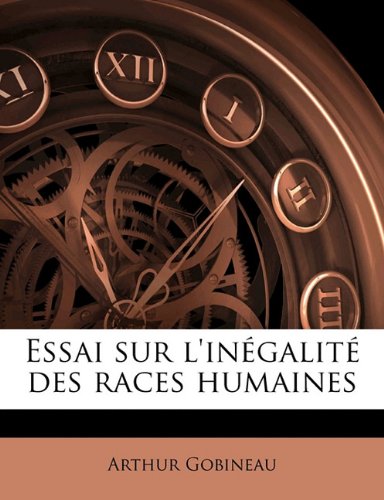
The Wikipedia article on “scientific racism” has the input of Jews and white liberals, but substantially edited it contains relevant info:
Classical thinkers
Benjamin Isaac, in The Invention of Racism in Classical Antiquity (2006), reports that scientific racism is rooted in Greco-Roman antiquity. A prime example is the 5th century BC treatise Airs, Waters, Places by Hippocrates, about which the Pseudo-Aristotle notes: “The idea that dark people are cowards, and light people courageous fighters, is found already in Airs, Waters, Places.”
A further example is the Roman writer, architect, and engineer Vitruvius (70-25 BC), who, relying upon the racial theories of the Greek Stoic polymath Posidonius (c. 135-51 BC), said:
…those races nearest to the southern half of the axis are of lower stature, with swarthy complexions, curly hair, black eyes, and little blood, on account of the sun. This poverty of blood makes them over-timid to stand up against the sword… On the other hand, men born in cold countries are, indeed, ready to meet the shock of arms with great courage and without timidity.
Enlightenment thinkers
Historian Henri de Boulainvilliers (1658-1722) divided the French as two races: the aristocratic “French race” descended from the invader Germanic Franks, and the indigenous Gallo-Roman race (the political Third Estate populace). The Frankish aristocracy dominated the Gauls by innate right of conquest, the contrary of modern nationalism. Despite supporting hagiographies and epic poetry, such as La Chanson de Roland, c. 12th century, he sought scientific legitimating by basing his racialist distinction on the historical existence of genetically and linguistically distinguished Germanic and Latin-speaking peoples in France.
Voltaire found biblical monogenism laughable, as he expressed:
It is a serious question among them whether the Africans are descended from monkeys or whether the monkeys come from them. Our wise men have said that man was created in the image of God. Now here is a lovely image of the Divine Maker: a flat and black nose with little or hardly any intelligence.
The Scottish lawyer Henry Home, Lord Kames (1696-1782) was a polygenist: he believed God had created different races on Earth in separate regions. In his 1734 book Sketches on the History of Man, Home claimed that the environment, climate, or state of society could not account for racial differences, so the races must have come from distinct, separate stocks.
Meanwhile, Carl Linnaeus (1707-1778), the Swedish physician, botanist, and zoologist, modified the established taxonomic bases of binomial nomenclature for fauna and flora, and was a pioneer researcher in biologically defining human race. In Systema Naturae (1767), he labeled several varieties of human species: the red Americanus, the Europeanus, the Asiaticus, the Africanus.
In 1775, Immanuel Kant published Über die verschiedenen Rassen der Menschen, which proposed natural or purposive causes of variation, as opposed to mechanical law or a product of chance. He distinguished four fundamental races: whites, blacks, Kalmuck, and Hindustanic, and attributed the variation to differences in environment and climate, such as the air and sun, but clarified by saying that the variation served a purpose and was not purely superficial. Kant argued that “the yellow Indians have a meager talent. The Negroes are far below them, and at the lowest point are a part of the American people.”
Charles White (1728-1813), an English physician and surgeon, tried to scientifically prove that human races have distinct origins from each other. He believed that whites and blacks were two different species. White was a believer in polygeny, the idea that different races had been created separately. His Account of the Regular Gradation in Man (1799) provided an empirical basis for this idea. White defended the theory of polygeny by refuting French naturalist Georges-Louis Leclerc, Comte de Buffon’s interfertility argument, which said that only the same species can interbreed. White pointed to species hybrids such as foxes, wolves, and jackals, which were separate groups that were still able to interbreed.
Christoph Meiners (1747-1810) was a German polygenist and believed that each race had a separate origin. Meiners studied the physical, mental and moral characteristics of each race, and built a race hierarchy based on his findings. Meiners split mankind into two divisions, which he labelled the “beautiful white race” and the “ugly black race.” In Meiners’ book The Outline of History of Mankind, he said that a main characteristic of race is either beauty or ugliness. Meiners also claimed the “Americans” were an inferior stock of people and wrote that the noblest race was the Celts. They were able to conquer various parts of the world, they were more sensitive to heat and cold, and their delicacy is shown by the way they are selective about what they eat.
Post-Enlightenment thinkers
Racial studies by Georges Cuvier (1769-1832), the French naturalist and zoologist, influenced scientific polygenism and scientific racism. Cuvier believed there were three distinct races: the Caucasian (white), Mongolian (yellow) and the Ethiopian (black). He rated each for the beauty or ugliness of the skull and quality of their civilizations. Cuvier wrote about Caucasians: “The white race, with oval face, straight hair and nose, to which the civilized people of Europe belong and which appear to us the most beautiful of all, is also superior to others by its genius, courage and activity.” Regarding blacks Cuvier wrote:
The Negro race… is marked by black complexion, crisped or woolly hair, compressed cranium and a flat nose. The projection of the lower parts of the face, and the thick lips, evidently approximate it to the monkey tribe: the hordes of which it consists have always remained in the most complete state of barbarism.
One of Cuvier’s pupils, Friedrich Tiedemann, was one of the first to make a scientific contestation of racism. He argued based on craniometric and brain measurements taken by him from Europeans and black people from different parts of the world that blacks have smaller brains, and are thus intellectually inferior.
The German philosopher Arthur Schopenhauer (1788-1860) attributed civilizational primacy to the white races, who gained sensitivity and intelligence via the refinement caused by living in the rigorous Northern climate:
The highest civilization and culture, apart from the ancient Hindus and Egyptians, are found exclusively among the white races; and even with many dark peoples, the ruling caste, or race, is fairer in color than the rest, and has, therefore, evidently immigrated, for example, the Brahmins, the Inca, and the rulers of the South Sea Islands. All this is due to the fact that necessity is the mother of invention, because those tribes that emigrated early to the north, and there gradually became white, had to develop all their intellectual powers, and invent and perfect all the arts in their struggle with need, want, and misery, which, in their many forms, were brought about by the climate. This they had to do in order to make up for the parsimony of nature, and out of it all came their high civilization.
Franz Ignaz Pruner (1808-1882) was a medical doctor who studied the racial structure of blacks in Egypt. In a book which he wrote in 1846 he claimed that Negro blood had a negative influence on the Egyptian moral character. He published a monograph on blacks in 1861, where he said that the main feature of the Negro’s skeleton is prognathism, which he claimed was the Negro’s relation to the ape.



